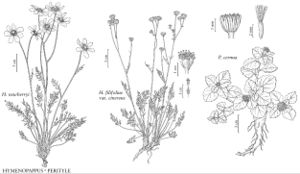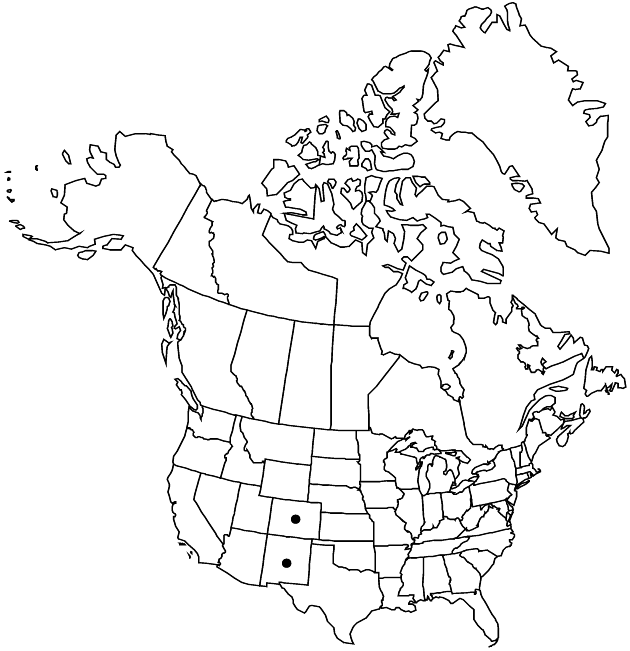Hymenopappus newberryi
Contr. Gray Herb. 68: 96. 1923.
IllustratedEndemic
Basionym: Leucampyx newberryi A. Gray ex Porter and J. M. Coulter Syn. Fl. Colorado, 77. 1874
Perennials, 20–60 cm. Leaves: basal 2-pinnate, 12–25 cm, lobes 5–15 (–25+) × 0.5–1.5 (–3+) mm; cauline 1–3 (–5). Heads 3–8 per stem. Peduncles 6–15 cm. Phyllaries whitish or yellowish, 8–10 × 4–7 mm. Ray-florets 8; corollas white or pinkish, laminae 14–20 mm. Disc-florets 60–150+; corollas yellowish, 3.5–4 mm, tubes 1.5–2 mm, throats campanulate, 1.5–2 mm, lengths 2–3 times lobes. Cypselae 3.5–4 mm, glabrous; pappi 0 or of 1–12+ scales 0.01–0.1 mm. 2n = 34.
Phenology: Flowering Jun–Sep.
Habitat: Clays or igneous soils, openings in aspen, pine, and spruce woodlands
Elevation: 2100–3000 m
Discussion
Selected References
None.
Lower Taxa
None.
... more about "Hymenopappus newberryi"
introrse +
connate +
herbaceous +
scarious +
absent +
hirsute +
papillate +
corymbiform +
continuous +
2-pinnate +
decurrent +
toothed +
1-2+ times pinnately lobed ultimate margins usually entire +
winged;ribbed;winged;ribbed +
1;15 +
stigmatic +
absent +
zygomorphic +
monomorphic +
12-16-ribbed +
dimorphic +
glabrous +
obpyramidal +
3.5mm;4mm +
staminate +
straight +
distinct +
proximal +
1;5 +
bisexual +
dispersed +
singly +
discoid +
aggregated +
indeterminate +
3;8 +
Present +
surrounding +
obconic;hemispheric +
petiolate +
alternate +
2-carpellate +
inferior +
attached +
anatropous +
persistent +
falling +
absent +
tough +
thick +
absent +
connate +
scarious-margined +
persistent +
distinct +
falling +
subequal +
Contr. Gray Herb. +
1923 +
pistillate +
absent +
fertile +
epaleate +
convex;flat +
fibrous +
exalbuminous +
modifed +
2;3 +
alternate +
erect +
scapiform +
2-branched +
papillate +
Hymenopappus newberryi +
Hymenopappus +
species +
2-3 times lobes +
campanulate +
equaling +
longer +
perennial +

